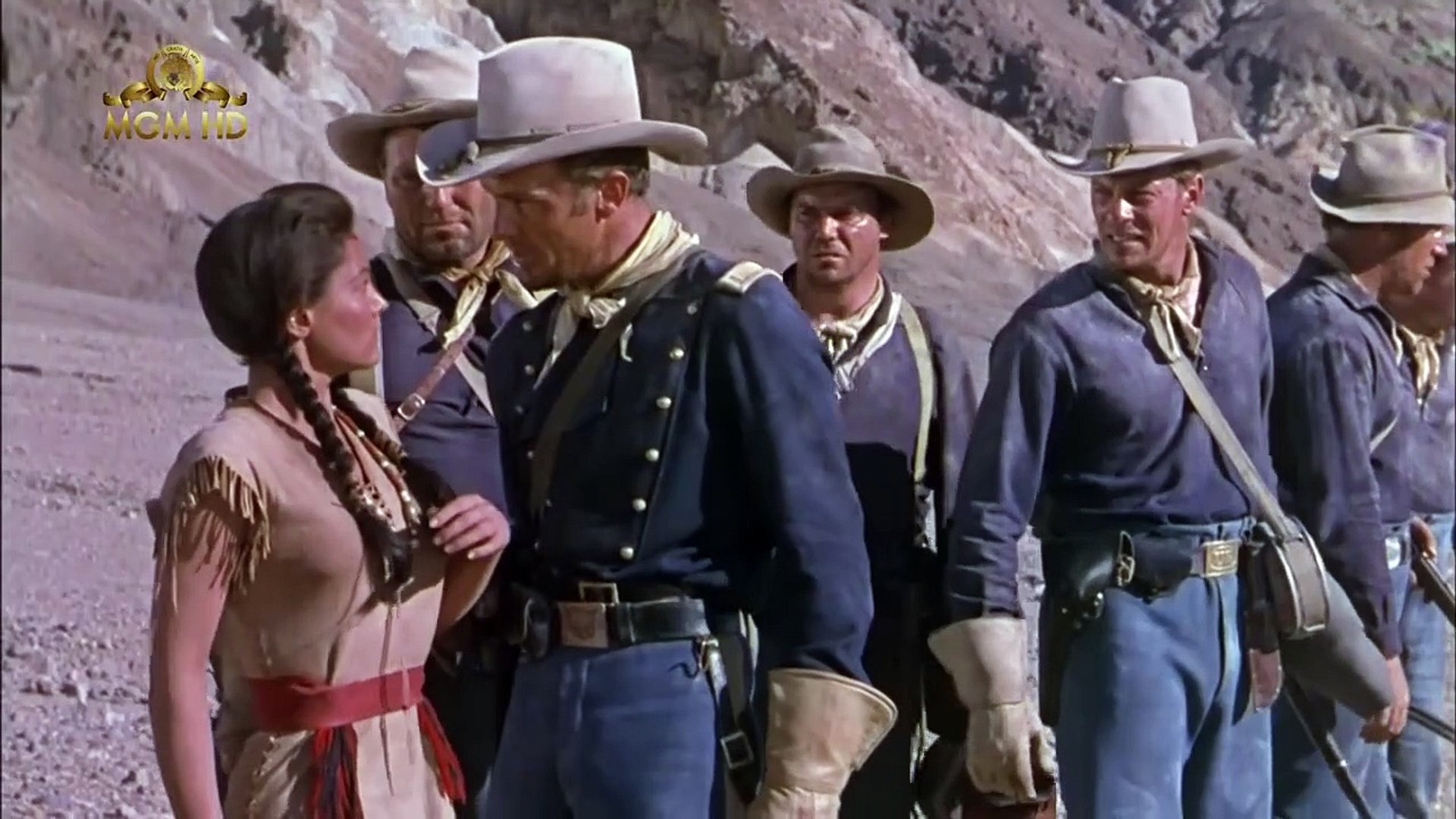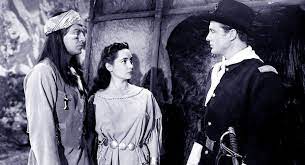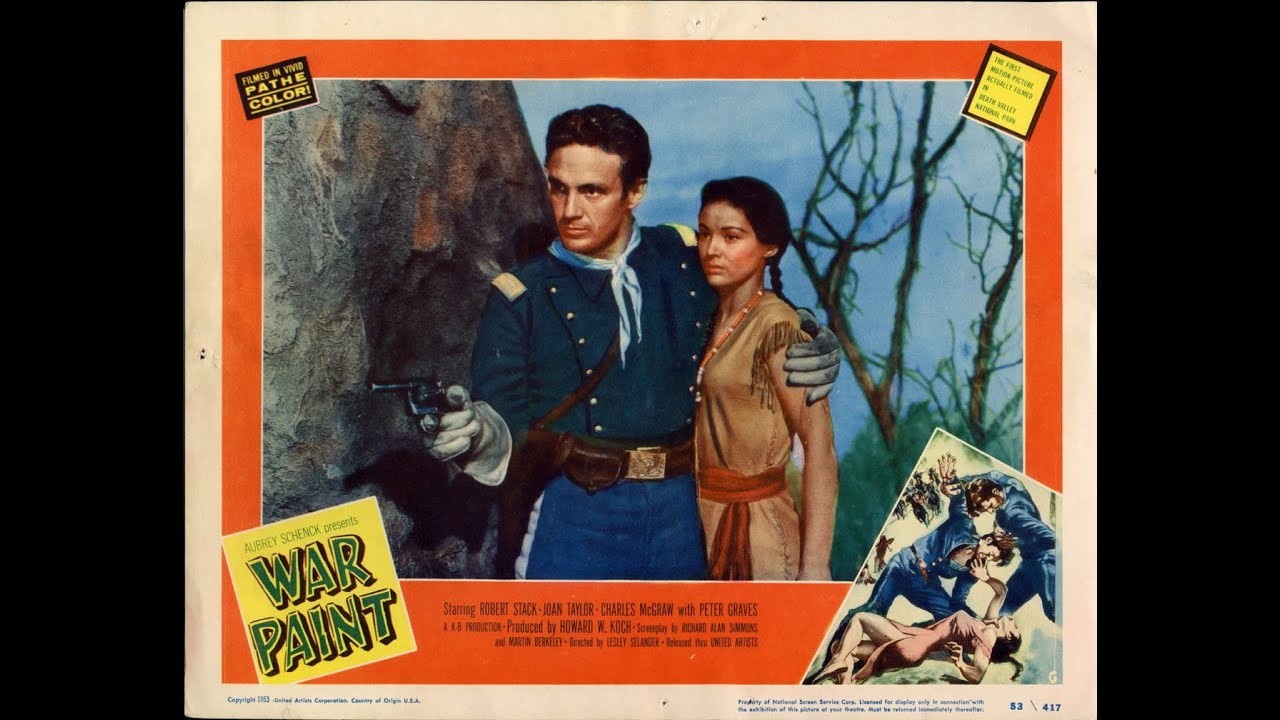🎬 War Paint (1953)

War Paint (1953) Review: A Tense Western Tale of Duty and Survival
War Paint, directed by Lesley Selander, is a gritty and suspenseful Western that centers on a U.S. Cavalry mission fraught with tension, moral dilemmas, and the unforgiving challenges of the American frontier. Starring Robert Stack and Peter Graves, the film explores themes of trust, betrayal, and the fragility of peace between cultures. With its tight narrative and intense atmosphere, War Paint offers a gripping story that captures the complexities of frontier life.
Plot Overview: A Race Against Time
Set in the arid deserts of the American West, the film follows Lieutenant Billings (Robert Stack) and his cavalry troop as they are tasked with delivering a treaty to a Native American chief. The mission is critical to maintaining peace in the region, but complications arise when the treaty is intercepted by Taslik (Keith Larsen), a young Native American scout with his own agenda.
Taslik claims to guide the troop to the chief but leads them on a grueling journey through treacherous terrain, testing their endurance and resolve. As supplies dwindle and tensions rise, the soldiers must navigate the physical and psychological toll of their mission, grappling with questions of loyalty, survival, and cultural misunderstanding.

Robert Stack as Lieutenant Billings: A Resolute Leader
Robert Stack delivers a strong performance as Lieutenant Billings, portraying him as a disciplined and determined officer committed to his mission. Stack’s portrayal balances authority with vulnerability, capturing Billings’ struggle to maintain order and morale as his men face increasing challenges. His steady leadership anchors the narrative, providing a moral compass amid the chaos.
Keith Larsen as Taslik: A Complex Scout
Keith Larsen’s portrayal of Taslik is one of the film’s highlights, offering a nuanced depiction of a character torn between his cultural identity and his personal vendetta. Larsen imbues Taslik with a quiet intensity, making him an enigmatic figure whose motives remain ambiguous for much of the story. His interactions with Billings and the troop drive much of the film’s tension.
Supporting Cast: A Diverse Ensemble
- Peter Graves as Trooper Tolson: Graves delivers a solid performance as one of Billings’ most reliable soldiers, showcasing the camaraderie and loyalty within the troop.
- John Doucette as Trooper Charnett: Doucette provides moments of levity and humanity, adding depth to the ensemble.
- Joan Taylor as Wanima: Taylor plays Taslik’s sister, who serves as a bridge between the Native American and cavalry perspectives. Her character adds an emotional dimension to the story, emphasizing the personal stakes of the conflict.
Themes: Trust, Betrayal, and Cultural Conflict
- The Fragility of Peace: The film underscores the delicate nature of peace between settlers and Native Americans, highlighting the consequences of mistrust and miscommunication.
- Survival in the Wilderness: The harsh desert environment becomes a character in itself, testing the physical and mental limits of the soldiers.
- Cultural Misunderstanding: The interactions between the cavalry and Taslik reflect the broader tensions and prejudices of the time, offering a commentary on the challenges of bridging cultural divides.
Direction and Cinematography: A Harsh, Unforgiving Landscape
Lesley Selander’s direction emphasizes the unforgiving nature of the desert, using wide shots of desolate landscapes to create a sense of isolation and desperation. The cinematography by Gordon Avil captures the stark beauty of the American West, with vivid contrasts between the sun-scorched terrain and the shadows cast by the characters’ internal conflicts. The visuals effectively heighten the tension, immersing viewers in the harsh realities of the frontier.
Action and Pacing: A Steady Build-Up
The film’s pacing mirrors the grueling nature of the troop’s journey, with moments of action punctuating the steady build-up of tension. Ambushes, internal conflicts, and the constant threat of betrayal keep the narrative engaging, leading to a climactic resolution that underscores the film’s themes of sacrifice and duty.
Historical Context and Representation
While War Paint attempts to present a balanced view of the tensions between Native Americans and settlers, it reflects the biases and stereotypes of 1950s Hollywood. The portrayal of Native American characters is more nuanced than in many contemporary Westerns, but certain elements still lean on simplistic or romanticized tropes.
Key Moments That Define War Paint
- Taslik’s Betrayal: Taslik’s true motives are revealed, adding a layer of complexity to the story and shifting the dynamics between the characters.
- The Troop’s Desperation: A sequence where the soldiers struggle to find water highlights the physical and psychological toll of their journey.
- The Climactic Confrontation: The final showdown between Billings and Taslik brings the narrative to a tense and emotionally charged conclusion.
Strengths of War Paint
- Tense Atmosphere: The film maintains a sense of suspense and urgency throughout, keeping viewers engaged.
- Strong Performances: Robert Stack and Keith Larsen deliver compelling performances that anchor the story.
- Stunning Visuals: The cinematography effectively captures the harsh beauty of the desert, enhancing the film’s immersive quality.
Weaknesses of War Paint
- Limited Character Development: While the main characters are well-drawn, some of the supporting cast feels underdeveloped.
- Pacing Issues: The film’s deliberate pace may feel slow at times, particularly during its quieter moments.
- Outdated Cultural Representation: Despite its efforts at nuance, the film’s portrayal of Native Americans reflects the era’s limitations.
Legacy and Reception
War Paint was well-received upon its release for its tense narrative and strong performances. While it has since been overshadowed by more ambitious Westerns, it remains a solid example of mid-century Hollywood’s approach to the genre. The film’s focus on moral dilemmas and survival sets it apart from more action-oriented Westerns of its time.
Fun Facts About War Paint
- Real Locations: The film was shot on location in California’s Mojave Desert, adding authenticity to its depiction of the harsh frontier environment.
- Keith Larsen’s Breakthrough: Larsen’s performance as Taslik helped establish him as a rising star in the Western genre.
- Military Collaboration: The film’s depiction of the U.S. Cavalry was informed by historical accounts, lending a degree of realism to its portrayal of frontier life.
Conclusion: A Suspenseful Western with Heart
War Paint (1953) is a gripping and visually striking Western that explores themes of duty, trust, and cultural conflict. Anchored by strong performances from Robert Stack and Keith Larsen, the film delivers a tense and thought-provoking narrative that highlights the harsh realities of frontier life. While some aspects of its representation and pacing may feel dated, its compelling story and striking visuals make it a worthwhile watch for fans of the genre.